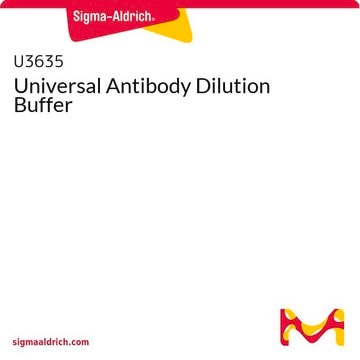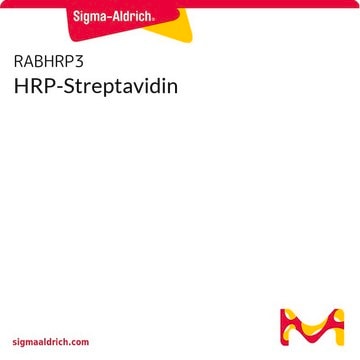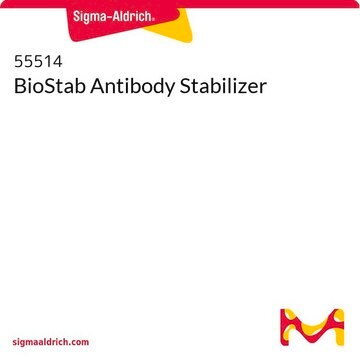U3510
Universal Antibody Dilution Buffer, Ready-To-Use, with BSA
Sign Into View Organizational & Contract Pricing
All Photos(1)
About This Item
UNSPSC Code:
12352107
NACRES:
NA.47
Recommended Products
pH
7.3-7.7
application(s)
hematology
histology
storage temp.
room temp
General description
Ready-to-use buffer for dilution of antibodies in all immunoassays. This buffer contains immunoglobulin free BSA and does not contain phosphate, sodium azide or mercury preservatives. It can be used for dilution of all antibodies, including peroxidase conjugates and antibodies to phosphoproteins. Not suitable for dilution of antibodies to S100 proteins.
Application
For dilution of primary or secondary antibodies. The diluted antibodies can be stored at 2-8 °C for several weeks.
Signal Word
Warning
Hazard Statements
Precautionary Statements
Hazard Classifications
Skin Sens. 1
Storage Class Code
12 - Non Combustible Liquids
WGK
WGK 2
Flash Point(F)
Not applicable
Flash Point(C)
Not applicable
Certificates of Analysis (COA)
Search for Certificates of Analysis (COA) by entering the products Lot/Batch Number. Lot and Batch Numbers can be found on a product’s label following the words ‘Lot’ or ‘Batch’.
Already Own This Product?
Find documentation for the products that you have recently purchased in the Document Library.
Customers Also Viewed
Erik Nutma et al.
Nature communications, 14(1), 5247-5247 (2023-08-29)
Microglial activation plays central roles in neuroinflammatory and neurodegenerative diseases. Positron emission tomography (PET) targeting 18 kDa Translocator Protein (TSPO) is widely used for localising inflammation in vivo, but its quantitative interpretation remains uncertain. We show that TSPO expression increases in
O Coban et al.
Andrology, 8(2), 421-426 (2019-08-09)
Sperm DNA fragmentation and its relation to conventional semen parameters are well studied. However, there is limited information regarding the rate of DNA double-strand breaks (DSBs) and its correlation to basic semen parameters and IVF outcome. The present study aimed
Erik Nutma et al.
Glia, 69(10), 2447-2458 (2021-06-20)
To monitor innate immune responses in the CNS, the 18 kDa Translocator protein (TSPO) is a frequently used target for PET imaging. The frequent assumption that increased TSPO expression in the human CNS reflects pro-inflammatory activation of microglia has been extrapolated
Juliana M Nieuwland et al.
Journal of neuroinflammation, 20(1), 179-179 (2023-07-30)
Coronavirus disease 2019 (COVID-19) patients initially develop respiratory symptoms, but they may also suffer from neurological symptoms. People with long-lasting effects after acute infections with severe respiratory syndrome coronavirus 2 (SARS-CoV-2), i.e., post-COVID syndrome or long COVID, may experience a
Shuang Wang et al.
Cell cycle (Georgetown, Tex.), 17(9), 1146-1153 (2018-06-14)
The tumor suppressor p53 is a key regulator of cell apoptosis and cell cycle arrest. Recent studies show that the delicate balance of p53 expression is important for neural tube defects, neuronal degeneration, embryonic lethality, as well as differentiation and
Our team of scientists has experience in all areas of research including Life Science, Material Science, Chemical Synthesis, Chromatography, Analytical and many others.
Contact Technical Service











